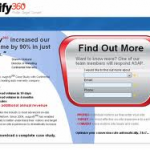 In early 2004 conversion rate experts were looking to improve on this and we saw the appearance of dedicated landing pages. These were designed with the single purpose of capturing the first time visitor and getting them to engage a little more so they would read further. Big, bold headlines and USPs around the search term were the order of the day.
In early 2004 conversion rate experts were looking to improve on this and we saw the appearance of dedicated landing pages. These were designed with the single purpose of capturing the first time visitor and getting them to engage a little more so they would read further. Big, bold headlines and USPs around the search term were the order of the day.
As these pages became more sophisticated they got better at matching the search terms to the perceived need of the visitor, often reflecting the search term back into a series of bullet points. This is really the early foray into personalised marketing.
As the internet in general is more trusted, site visitors became comfortable leaving information on web-sites far earlier in the sales cycle. So we saw data capture forms and Buy-Now buttons starting to appear on these landing pages.
Compared to conventional deep-link pages these dedicated landing pages were a universal success. Typically you would expect a well-written landing page to convert 50% more visitors than deep-link landing pages.
There were a few other distinct benefits of using dedicated landing pages:-
1. The pages were lightweight, typically less than 50k in size and this reduced page-load time helped conversion rates greatly.
2. Google’s interesting policy of “rewarding” a higher position to landing pages that have greater relevance (quality score) meant that the landing page could be built with this in mind to further reduce the cost of Adword campaigns.
3. Campaigns could be run based on geo-based information such as Google local terms and search terms that included geographical references. Better geo-targetting produces better results.
4. Testing these landing pages was easy, you could easily create a raft of different landing pages and test them side-by-side. Even new campaigns could be raced against existing “banker” (proven) landing pages.
5. Companies could now create hundreds of landing pages for different scenarios, different times of day and different seasons. Personalisation was the key here. If you could segment your PPC traffic then you could segment where they landed the therefore how they were treated.
6. De-cluttering the landing pages was easy, traditional navigation items could be moved off the the page to generate a highly-focussed environment using an aggressive Choice Environment.
7. Reporting on success of landing pages was (on the face of it) simpler.
They did, however, suffer from being a one-trick pony. If the page didn’t work then the limited other navigation choices available can cause the visitor to [BackSpace] off the Landing Page and back to Google. Alternatively the visitor would find the odd link to “visit Main site” and then be dumped back on the home page or a deep-link page. The visitor may subsequently convert but it’s pretty unusual to track this conversion back to the Landing Page unless you have a visitor-centric web platform.

